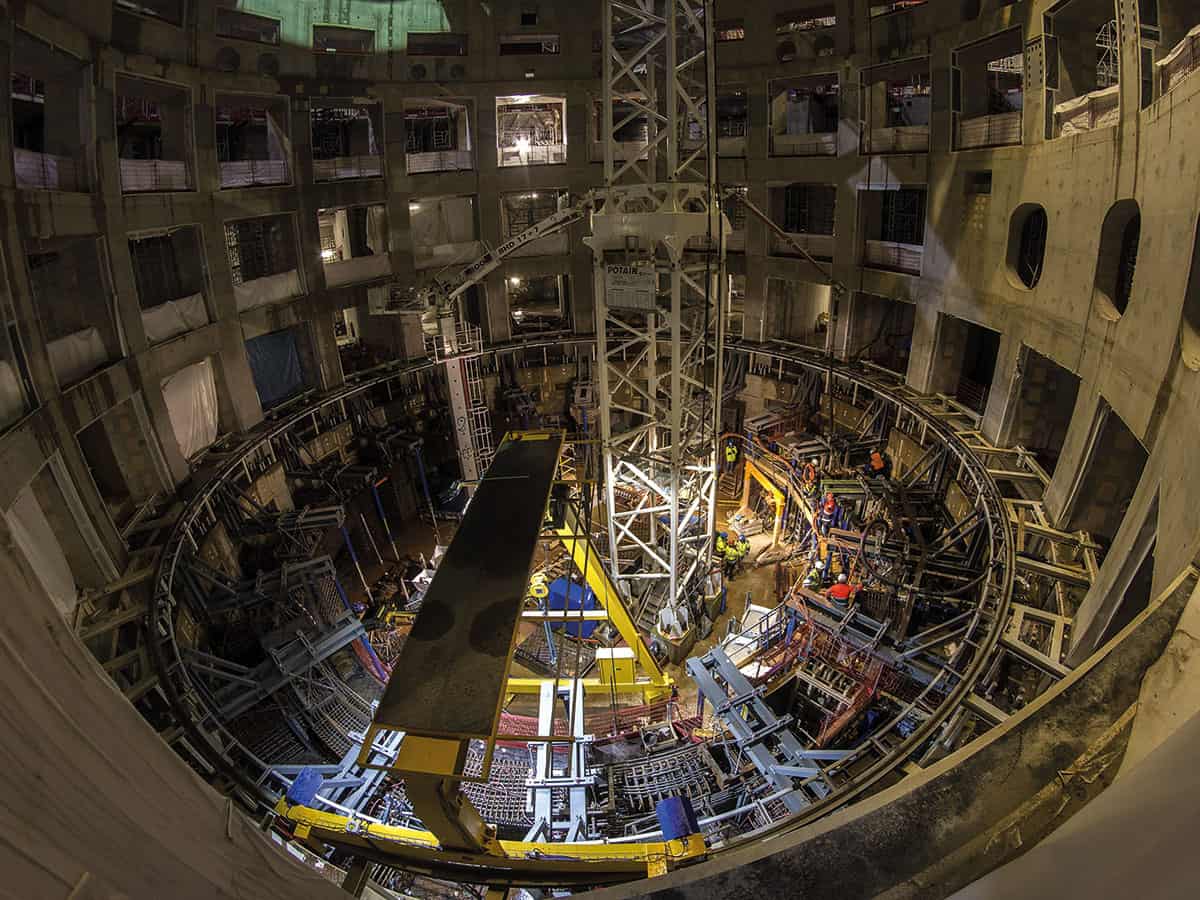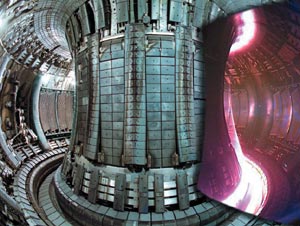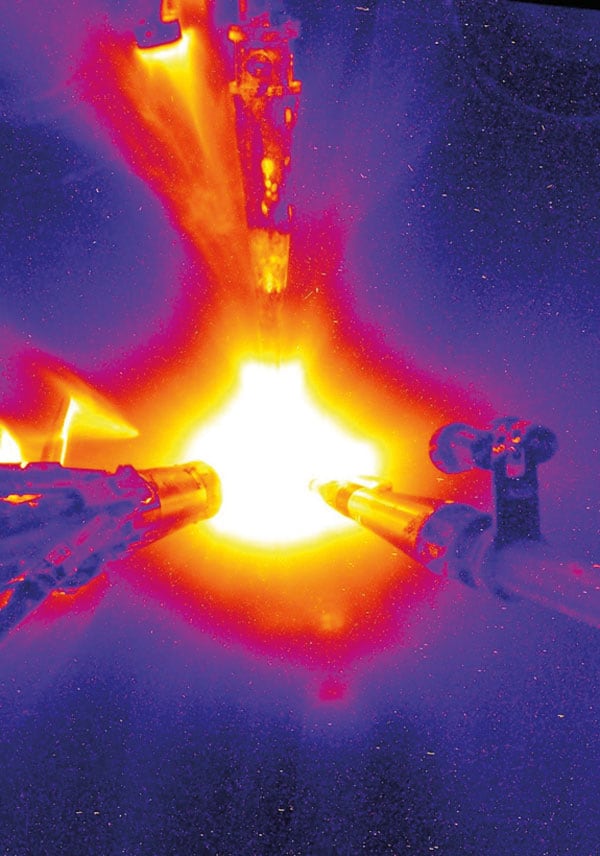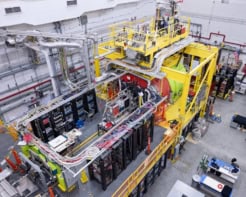Reproducing the energy of stars here on Earth could revolutionize how we fuel our lives. But why does fusion energy always seem to be 30 years away? Melanie Windridge investigates
Scientists have been trying to harness nuclear fusion – the energy of the stars – since the 1930s. The reaction, in which atomic nuclei form one larger nucleus, releases huge amounts of energy according to Einstein’s E = mc2. But it requires extreme conditions for the positively charged nuclei to overcome the Coulomb repulsion between them. That’s why fusion occurs naturally only at the centre of stars.
Scientists are keen to reproduce the process on Earth because it could mean an almost-unending power source. The journey so far has not been smooth, with media sensations, funding worries and false hopes. And yet, despite the setbacks, there has been steady progress towards the dream of clean and abundant energy.
Physics World’s debut year saw one of the biggest dramas in fusion research. On 23 March 1989 Stanley Pons from the University of Utah in the US and Martin Fleischmann of the University of Southampton in the UK announced that they had achieved fusion at room temperature – so-called cold fusion. They had performed an electrolysis experiment that involved deuterium from heavy water being crammed into a palladium electrode. And they believed that if the deuterium could be packed tightly enough, fusion could occur. Pons and Fleischmann detected excess heat, which they said could not be explained by chemical processes alone so must be due to nuclear fusion.
Teams from various institutions around the world immediately attempted to replicate the findings but everyone had difficulty reproducing the results and most failed entirely.
Writing in the May 1989 issue of Physics World, Thornton Greenland – a theoretical physicist from Harwell Laboratory in the UK – calculated how much the Coulomb interaction between deuterons would need to be screened out to explain the fusion rates implied by Pons and Fleischmann’s data. His conclusion: “It is difficult to find simple explanations for the phenomena [they] reported…there are severe difficulties in establishing a consistent experimental picture.”
Cold fusion seemed dead and planned meetings between Pons and the US Congress regarding a National Cold Fusion Institute were cancelled. Experiments continued into the 1990s, all discrediting Fleischmann and Pons’ claim. While a small amount of cold-fusion research continues to this day, it now usually goes by the name LENR (low-energy nuclear reactions) – perhaps to avoid association with the drama of 30 years ago.
Bad times continued
Cold fusion wasn’t the only bad news for fusion research during that first year of Physics World. In December 1988 the magazine reported that Britain’s fusion programme was to be slashed by £5m over the following three years, representing a 25% cut to its budget. Since funding was protected for the Joint European Torus (JET) – the tokamak located at what is now the Culham Centre for Fusion Energy in the UK – the decision meant cuts to other research lines such as a reverse-field pinch experiment. One senior source at Culham dubbed the cuts as “silly” given that other techniques “may in the long term have better potential”.
Although some experts quoted in that December 1988 issue were critical of how long fusion was taking to become commercially viable, Paul Thomas of JET and Mike Key from the Rutherford Appleton Laboratory in the UK were reported as saying that “the next generation of experiments should be able to demonstrate thermonuclear ignition” – the point at which fusion reactions become self-sustaining. At this time there were several “next step” magnetic confinement devices on the table. There was a divergence of opinion between compact designs with high magnetic fields such as Italy’s IGNITOR, and large reactor-like devices. The latter included Europe’s Next European Torus (NET) and the International Thermonuclear Experimental Reactor (ITER) – a collaboration then run by Europe, the US, the Soviet Union and Japan. The former, high-field approach was seen to be more risky because the high-temperature operation of such devices was unproven.
Meanwhile, the inertial-confinement fusion community was also divided between two promising approaches. On the one hand, there was direct drive, where powerful laser beams are focused on a peppercorn-sized spherical fuel pellet, compressing it through ablation of the outer layer. On the other there was indirect drive, where the laser light used to compress the fuel pellet is converted into soft X-rays inside a cavity to improve the uniformity of illumination.

Yet to ignite
Skip forward 30 years and we are still waiting for ignition. The problem is that most funding and effort have gone into approaches that might be less scientifically risky, but are big and expensive. Those in the magnetic-confinement camp abandoned plans for NET and indefinitely delayed IGNITOR, focusing instead on the large, reactor-like device ITER. Meanwhile, those championing inertial confinement directed their attention to the indirect-drive approach, building facilities such as the National Ignition Facility (NIF) at Lawrence Livermore National Laboratory in the US. Such approaches seem sensible to reduce risk, but with hindsight I feel that the political will and consequent funding did not match the ambitions of the fusion community, which has caused long delays in both programmes. NIF did not begin operating until 2009, while ITER is still being built in Cadarache, France, with first plasma not expected to be reached until 2025 – some 40 years after the project was first envisioned.
That’s not to say there’s been no progress. We have learnt a lot about plasma physics and particularly the plasma instabilities that prevent the high temperatures required for fusion – hundreds of millions of degrees – from being reached. Tokamaks around the world have furthered our knowledge of how to magnetically contain fusion fuel and heat it to achieve the conditions required for fusion. In the 1990s experiments with a deuterium–tritium (D–T) fuel mix at magnetic-confinement machines JET and the Tokamak Fusion Test Reactor (TFTR) at Princeton Plasma Physics Laboratory in the US produced fusion despite never managing to get past energy breakeven, where Q – the ratio of fusion power to heating power – exceeds 1. JET still holds the world record of Q = 0.64 from 1997.
JET has been running successfully now for over 30 years and is still at the forefront of fusion research. Much of its work is in preparation for ITER, such as plasma-physics research, systems testing and materials investigations. As for NIF, it has not managed to achieve ignition – even if it has come close – but it has recently set a new record on its laser system, firing 2.15 MJ of energy at its target chamber, which is 15% over its design specification of 1.8 MJ. Expanding NIF’s energy limit will significantly boost the pursuit of ignition, as will improving the uniformity of its pellet implosions. NIF researchers have even reported this year generating fusion energy twice that of the kinetic energy of the implosion, although this latest energy output is less than a thirtieth of that needed for ignition.
The optimism of 30 years ago has been rather thoroughly dissipated. Sadly, the scale of the endeavour and the difficulty of obtaining funding were rather underestimated
“The optimism of 30 years ago has been rather thoroughly dissipated,” says Paul Thomas who now works for fusion start-up Tokamak Energy. “While the D–T experiments on JET and TFTR were successfully carried out, most of the next-step paths have either come to nothing or are substantially delayed. Sadly, the scale of the endeavour and the difficulty of obtaining funding were rather underestimated.”
Revisiting old ideas
Looking back at articles from Physics World’s first year, it is interesting to note a resurgence in some of those old ideas that were thrown out 30 years ago. Private money is increasingly being invested in start-ups investigating a range of different approaches including magnetized target fusion, the field-reversed configuration, dense plasma focus and inertial confinement fusion in bubbles, as well as more mainstream approaches such as the tokamak. In 2015 the US Department of Energy’s Advanced Research Projects Agency-Energy (ARP-E) – which aims to advance high-potential, high-impact energy technologies that are too early for private-sector investment – launched a programme to support alternative approaches to fusion energy. And where the familiar tokamak is concerned, start-ups such as Tokamak Energy, for which I am a consultant, are revisiting the high-field, compact approach now made possible by the commercial availability of high-temperature superconductors.
All these private attempts are focused on easing the transition to commercialization, and some have come together to form a consortium to push for a fusion XPRIZE or equivalent award. They recognize that the key to achieving fusion is – as it ever has been – funding. Stimulating excitement, investment and innovation in the way the first Ansari XPRIZE drove the private space programme could be just the thing needed to achieve fusion lift-off. Much more public engagement is also needed to challenge the old stigma of fusion being always 30 years away – essentially impossible. The reality is that seeking to sustain conditions found naturally only in stars is no simple undertaking.

Fusion: the way ahead
It is hard to predict where fusion will be in another 30 years. I’m sure I speak for the whole fusion community when I say that I hope we have commercial fusion power plants up and running. If any of the start-ups achieve their ambitious goals, we will have. What is clear is that the will to achieve fusion is reaching beyond the academic community and into the commercial realm, so it will be interesting to look back on this period in 30 years’ time.
The favoured fuel and techniques

Deuterium (D or 2H) and tritium (T or 3H) are generally the fuels chosen for fusion power on Earth. Although hydrogen–boron reactions don’t produce damaging neutrons, D–T fusion wins out because the temperature required for it is only about 150 million °C, making it easier to achieve. But to harness the incredible potential of fusion, you have to hold the fuel plasma with sufficient ion density at the necessary temperature for long enough for fusion reactions to get started.
Various approaches have been investigated to fulfil this criterion. Magnetic confinement involves holding stable a relatively lower density plasma for a relatively longer time using magnetic fields, while inertial confinement uses rapid compression (usually by lasers) to create higher densities for very short periods of time. Both these methods can initiate fusion.
The tokamak is the best-performing magnetic-confinement device, though other designs such as the stellarator, Z-pinch and reverse field pinch are also being studied. Tokamaks use an internal vacuum vessel shaped like a ring doughnut, with magnetic coils wrapped around this “toroid” to create a magnetic field through the ring. A current flowing in the same direction through the plasma generates a perpendicular magnetic field to stop particles drifting outwards. Other external magnetic coils shape and control the plasma, which is heated externally by firing in either radio waves or beams of neutral particles that transfer their energy to it.




